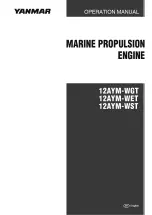
©2015 Toni Clark practical scale GmbH Zeiss-Str.10 D-32312 Lübbecke Tel. 0049 5741/5035 Fax. 05741/40338 www.toni-clark.com
Valach VM 120 B2-4T Instructions
17
Installation of the fuel tank
It is better for the fuel tank to be built into the model at a level above that of the carburetor.
The carburetor has non-return valves fitted, so that the fuel cannot run out through the
carburetor as long as the engine is not running. For starting, it is better when the fuel line
is full with fuel. With the engine running, it does not matter how long the fuel line is. You
can install the tank anywhere you please in the model, at the CG position for example. But
keep the fuel line as straight as you can. Avoid bends that will hold air bubbles.
It is impossible to prevent the fuel in the tank from foaming. This foaming means you must
use our special cotton felt clunk filter - omit this clunk filter and your engine will draw more
air than fuel. Model aircraft fuel filters are useless for petrol engines; the transparent auto-
motive paper element fuel filters are also useless. The former have too coarse a mesh, and
the latter have a large capacity, allowing air to accumulate and thereby causing the engine
to stop, due to the sudden ingestion of this accumulated air by the carburetor. The second
and very important reason for using our cotton felt filter is that in petrol there is always a
certain amount of suspended matter, that is almost impossible to see with the naked eye.
This dirt will easily pass through the model filter and build up in the carburetor, mainly in
the low speed fuel passages. When this happens, the only cure is a new carburetor.
Fitting a T-piece in the fuel line between the tank and carburetor for fueling will be an
obvious mistake to most folks, but we have seen this method of short-circuiting the felt
clunk filter in the tank, with the obvious results, more often than one would imagine.
Here you can see the cooling air
ducting into the giant Pitts cowling.
The baffles consisting of 4 mm
balsa, glued in with thick cyano.
Then I coated them with a layer of
dope. Afterwards I painted them
grey with a two component paint.
The visible lower baffle plays a
mayor roll in cooling the engine.
It prevents the air from “diving”
under the cylinders and flowing the
shortest way to the outlet on the
bottom of the cowling.








































